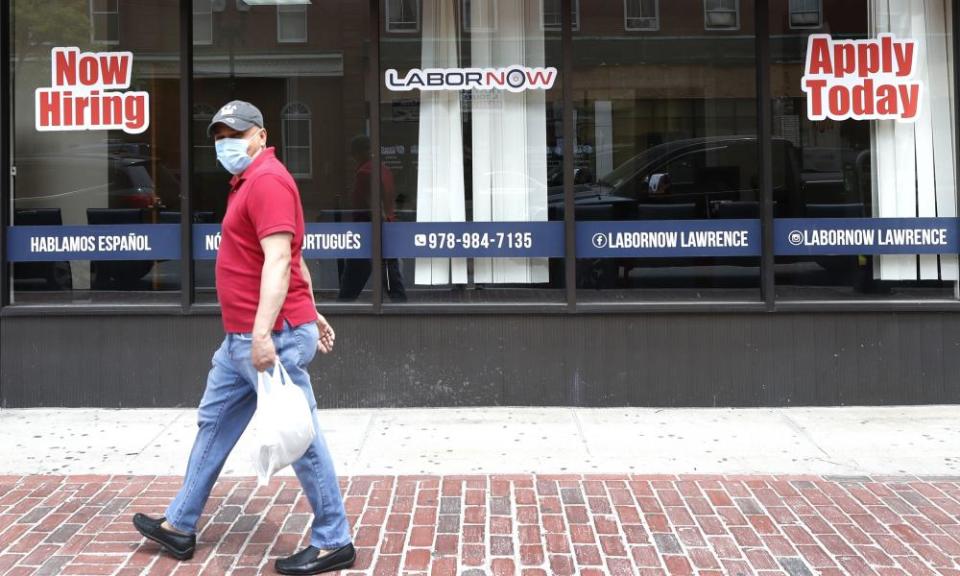Behind the US unemployment figures: five key points from May's jobs report

Friday brought hope that the US economy is finally digging its way out of the rubble after Covid-19 wiped out millions of jobs – with no indication of when they would be coming back. But beneath the surface, deep problems remain.
Related: US unemployment hits 40m – in pictures
The Department of Labor’s monthly jobs report brought surprising news that the unemployment rate decreased to 13.3% and the economy gained 2.5m jobs in May.
The report, which is released at the beginning of each month, differs from the weekly unemployment report the department releases every Thursday. The monthly report comes from a survey administered in one week in the middle of the month (in May, it was administered 10-16 May). Meanwhile, the weekly reports come from states reporting the number of new unemployment claims they received that week.
The headline figures from the latest monthly report indicate the risky game of reopening America means jobs are coming back but other measures in the report indicate the widespread economic devastation has not been relieved yet.
Here are five key takeaways from the report that show it is a more sobering picture of the economy:
1. Racial disparities remain
While people may be celebrating that the national unemployment rate in May fell from 14.7% in April to 13.3%, the black unemployment has remained virtually unchanged. In April, the black unemployment rate was 16.7%, in May it was 16.8%.
Meanwhile white Americans saw the largest decrease in unemployment of any racial group, going from 14.2% in April to 12.4% in May. Historically, the white unemployment rate is lower than the national unemployment rate, while black unemployment can be nearly twice as high.
Hispanic Americans are still seeing the highest unemployment rate of any racial group, with a 17.6% unemployment rate in May, down from 18.9% in April.
These #JobsDay numbers highlight the damage of the coronavirus ression—a recession that has caused greater job loss in black households than white households and that will, as a result, exacerbate existing racial inequalities. 10/
— Heidi Shierholz (@hshierholz) June 5, 2020
2. 19.6m jobs are still gone
While 2.5m jobs coming back is not insignificant, March and April saw 1.4m and 20.7m decreases in employment, respectively. That means that 19.6m have still not come back since shutdown orders were put in place in March.
Here's a simple but important picture of what's happening to jobs. Extremely welcome reversal, of course, if it sticks, but the magnitude of the losses means that even if this uptick pace continues, it would take almost a year just to make up lost ground. pic.twitter.com/kClNyb5kUz
— Jared Bernstein (@econjared) June 5, 2020
3. Hospitality and leisure gained 1.2m jobs but still has a 35% jobless rate
Almost half of the employment gains in May were from the hospitality and leisure industry, which has been the industry hit hardest by shutdown orders. In May, the industry saw a 1.2m increase in jobs after it lost 7.5m jobs in April and 743,000 jobs in March.
Other hard-hit industries saw increases in employment: construction added 464,000 jobs, education and health services 424,000 and retail recorded an increase of 368,000.
But unemployment rates in those industries remain high. Leisure and hospitality had a 35.9% unemployment rate in May, nearly three times the overall national unemployment rate. Retail had the second-highest unemployment rate of any industry at 15.1%.
4. Millions more people gave up looking for work or had their hours cut
The official unemployment rate only counts people who indicated they are willing and able to work and are currently not working in any capacity. But millions more people whose jobs have been affected by the economic crisis are not represented in that rate.
Many people are still working, but had their hours cut – perhaps because they were a server at a restaurant that is now just doing takeout or they work at a grocery store that reduced the hours it is open. These people want to be working a full, 40-hour work week, but cannot. More than 10 million people indicated they were working part-time because of economic conditions, either business conditions have worsened or they could only find part-time work.
The U-6 is the unemployment rate that includes the total unemployed plus people who have given up looking for work or are working part-time but want full-time employment. The U-6 in February was 7%, while in May it was 21.2%. This gives a more in-depth picture of how many workers have been affected by the pandemic.
5. The unemployment rate is probably higher than it appears
For the last few months, the Department of Labor has admitted that the official unemployment rate is probably higher because people are not filling out the survey correctly.
The survey allows people to indicate they are employed but absent from work the week the survey was conducted and asks them to list the reason why, such as childcare, medical purposes, school or vacation. The survey instructs those who are employed but are not at work due to coronavirus to be marked as unemployed on temporary layoff.
But the department noted that a higher-than-usual number of people indicated they were employed but not at work for “other reasons” and suspect that they are misclassified. While in other years during this time, about 500,000 said they were employed but out of work for “other reasons”, in May, that number climbed to 5.4 million.
If those workers “had been classified as unemployed on temporary layoff, the overall unemployment rate would have been about 3 percentage points higher than report”, the Department of Labor said in May’s report. The department said it was investigating how it could mitigate the misclassification in the future.

 Yahoo Finance
Yahoo Finance 